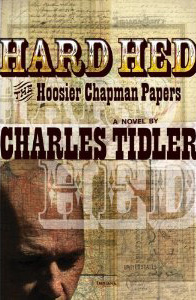Reviews
Fiction Review by Mike Matthews
Charles Tidler, Hard Hed: The Hoosier Chapman Papers (Vancouver, Anvil, 2011). Paperbound, 178 pp., $20.
For readers who might suppose Hoosiers are something close to hosers, or whose notion of the Hoosier state has to do with “moonlight on the Wabash” in an old pop song, Charles Tidler, who spent his youth in Indiana, provides a historical-poetical-surrealistic portrait of that state of the American union, from the Indian Wars of the early nineteenth century through to near the end of the twentieth. Further, this novel, though set entirely and firmly in the American Midwest, constitutes a fable of regeneration in nature generally, and in some specific human strains.
Across the planet and over a great span of time, the humble apple has produced endless attention as a generator of metaphors of birth and beginning. In Tidler’s account, the hero is a past and present-day Johnny Appleseed, more reviled than honoured in his home land, despised by even his father for planting “goddamn spitter trees.” The five-part novel begins with a soldier’s journal, illiterate, banal, and horrifying, from the wars that drove the Natives from the Indiana territory, specifically the sorties, skirmishes, and slaughters around the battle at Tippecanoe. It tells of the rise, at once ruthless and hapless, of Daniel Linkhorn from foot soldier to Brigadier General in a genocidal campaign of seventy-two days, a campaign in which Linkhorn’s main aims have been to get burial for soldiers who have, fatally wounded, “cryd like panthers” and “dyed,” obtain feed for his “hors,”and “quorts” of whisky for himself.
The succeeding four books of the novel bring the reader to recent times. Introduced in Book Two is Hoosier Chapman, related to Daniel Linkhorn, and also, it seems, to John Chapman, the historical Johnny Appleseed. Hoosier, with “dark brows steep as a dog days crick bank” and wearing a jail-issue orange jumpsuit (planting apple trees illegally), is riding in the middle of the bus for safety in case of accident. Tornadoes, we are told, “touch down with talons to snatch whole towns,” and the bus in which Chapman is riding is sliced in half by one such windstorm “like a hatchet through a can of beans.” Hoosier’s survival of the tornado is one instance of the nine-lives perenniality that Tidler gives him. We follow Hoosier to a reading featuring author William Gass, celebrant of the American Midwest, at which he fights with Gass and pursues a romance begun on the bus with another William Gass fan, a local Indian girl. Chased by policeman Dick Fidler, Hoosier assaults him, dives into a creek to get away, and leaves the girl behind. She is found murdered the next morning and suspicion falls on Chapman. Uncertainties and gaps in the narrative allow us to suppose that Fidler, violent and erratic, may be the murderer.
Book Three moves back in time again to give a history of the Wabash River valley from the period of the Indian Wars into the twentieth-century farming era, with emphasis on the hardships of early farmers “pulling up the wild by its original squealing roots,” and on the growth of Christian fundamentalism and the Ku Klux Klan. Book Four brings Hoosier back, and we see the culture of the valley showing itself as unfriendly to Indians, black Americans, and apple-tree-planting, roving troublemakers. Shot by Dick Fidler, his “hard head exploding like a mushmelon,” Hoosier is reincarnated again one dawn later, in Book Five, emerging from a ditch in his prison-orange coveralls, head intact, singing, and “simply so gosh darn happy to be alive today.”
There’s ceaseless energy in Tidler’s writing. A poet, dramatist, and jazz spoken-word performer, he provides exhilarating stichomythic passages, back-and-forth, thrust-and-parry bouts, in dialogue scenes. He describes events beneath “an apple butter full moon” and moves sharp-eyed into the realm of the prosaic when he describes a hospital dinner, at once the worst and the most precisely described hospital meal ever to fall into ink. When, on an exit from a hall, “the sharp brass latch of the hardwood door snaps,” virtually every word registers the event in sound as well as sense.
Like any book published in these days of haphazard editing, Hard Hed invites some red-pencil work. A transitive verb tries to do the work of an intransitive one, a hyphen wanders into the wrong gap, and the sleazy adjective “multiple” is misused in describing the many limbs of a Hindu god. These are small blemishes on a text full of invention, virtuosity, and vitality. Tidler’s novel bounces and cartwheels with metafictional asides and lightning shifts of perspective and focus.
—Mike Matthews









